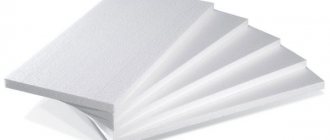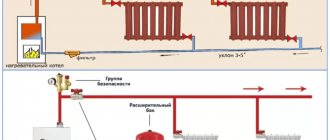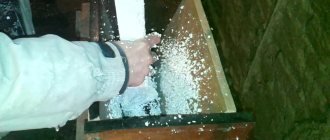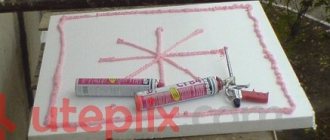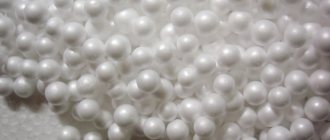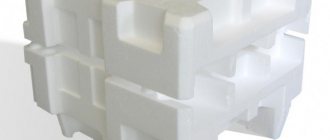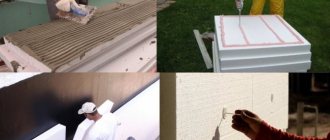Thermal cutter. Foam cutting machine. Mobile “goat” for cutting polystyrene foam. An electrical device made of nichrome thread, LATR, transformer or computer power supply has many names. It can be used everywhere. Make a wet facade based on foam plastic. Make carved decor for wall decoration or various crafts from PPS. Another plus is that the thermal cutter cuts foam plastic and EPS faster and better than a hacksaw or knife. It's not difficult to make it with your own hands. We offer you 4 options of machines for cutting expanded polystyrene, from trikopek ones - assembled from various “unnecessary items”, to the most advanced ones - based on a welding inverter.
Homemade machine for cutting foam plastic from LATR, transformer and nichrome thread
Most do-it-yourselfers make a heat cutter from what they have on hand. If they buy anything, it’s nichrome thread. The rest is found by scraping the bottom of the barrel. This is exactly what a FORUMHOUSE user with the nickname Electron did.
Electron
I insulate the house with polystyrene foam. I bought PPS with a thickness of 5 and 10 cm. First I cut it with a knife along a ruler. Inconvenient. I decided to make a thermal cutting machine for polystyrene foam. Things went faster with him. To make it I needed:
- table-workbench (was available);
- aluminum corner;
- aluminum profile;
- steel corners;
- wooden block with a section of 5x5 cm;
- chipboard sheets left over from an old cabinet;
- transformer for 650 W and 36 Volts and LATR (were on the farm);
- nichrome wire with a diameter of 0.5 mm and a length of 5 m (bought on the market).
The user did this with a machine for cutting PPS - he passed a nichrome thread through a hole in the table. The thread passes through the ceramic socket from the radio tube. To tension the wire, Electron took an M10 stud with nuts. He ground off flats from one edge and drilled a transverse hole. I threaded a spring into it. He clamped the end of the spring into a polyethylene brass terminal block. I clamped the string and the supply wire into the second end of the terminal. This is necessary so that the current does not flow through the spring, and it does not lose its springy properties. After applying voltage, the tension of the nichrome thread is adjusted using a pin.
The spring compensates for changes in the length of the nichrome thread when it is heated and cooled.
Electrical diagram of a homemade foam cutting machine.
Electron
I cut sheets measuring 1.2 x 1 m on the machine. I made about 150 cuts of foam plastic with one string. Didn't burn out. The cutting speed of PPS with a thickness of 100 mm is 10 cm per second. Be sure to make a third thread attachment point. In my case, this is a hole in the table where a ceramic socket from a radio lamp is attached. The optimal filament heat is not to red, but so that it is barely visible in the dark. Those. - almost dark.
Changing machine parameters
When making machines for cutting foam plastic, it is necessary to take into account the fact that in the future there will be a need to cut thicker sheets of materials, while short screws can be unscrewed and longer ones installed in their place. In order to press in, you need to make a hole in the base. Its diameter should be less than this indicator characteristic of the rack, the difference should be 0.5 millimeters. When making machines for cutting foam plastic, the racks need to be driven into the holes with a hammer, but to facilitate the procedure, it is necessary to process the sharp edges of the ends with sandpaper. Before you start screwing the screw into the rack, you need to cut out a groove under its head. In order to do this, you need to clamp its end with a screwdriver, while a thin file should be placed under the head, and then rotate. The groove is necessary in order to strengthen the wire in one position, which can move during adjustment. In order for the wire not to sag, elongating after heating, it must be fixed to the springs, and then to the screws. When making machines for cutting foam plastic, you need to prepare all the fasteners, and then strengthen the nichrome wire. In order to ensure reliable contact between it and the current-carrying wire, you need to use a technology called “unwinding with crimping”. The copper wire must have a cross-section of at least 1.45 sq. mm.
Mobile “goat” for cutting foam plastic
The machine described above is operated stationary. But, when installing wet facades based on polystyrene foam, workers have to move on scaffolding. Unfold the sheets according to thickness. Cut out shaped elements from PPS, etc. A heavy machine is inconvenient, and you don’t want to go down every time. Exit? Make your own mobile thermal cutter, the so-called. "goat".
Oleg LvovichSpecialist in installation of wet facades
On facades we work with mobile “goats”. They make it easy to navigate through forests at height. You can cut the foam directly on site. We dissolve the sheet thickness along two profiles. The profiles are attached to the PPS using nails. How to work with the device is clearly seen in the video below.
The cutter is made on the basis of a 250 W transformer, which produces 36 V. The length of the rail is 1370 mm.
Oleg Lvovich
The cutter worked on facades for four seasons. Three times he fell from the scaffolding. Nothing is broken. The string was not changed. The second cutter was used for three seasons. The wire was changed 5 times. It burned out. The reason is that its string is 10 cm shorter than that of the first cutter.
If there is a transformer, then the cost of purchasing the necessary parts for a thermal cutter does not exceed 1000 rubles.
Electrical circuit of a mobile foam cutting machine.
And in this video, FORUMHOUSE user smoke explains in detail how to make a similar nichrome cutter with your own hands.
Getting 2d shapes
When producing two-dimensional parts on the SFR-Standard unit, files in PLT format are required. To open the required file, you need to select “2d figure processing” in the menu.
After the file is loaded into a separate program window, you can use the “edit” button for more productive setup and management. With its help, missing details are adjusted, corners are smoothed, and the scale of the figure changes. Having loaded the created files and configured certain parameters for the machine, further control is carried out using three buttons:
- soft launch;
- pause;
- stop.
Foam cutting machine based on a computer power supply
Not all home craftsmen have a transformer lying around in their bins, but many have a power supply from an old computer lying around gathering dust. It's good that you didn't throw it away. It will come in handy to make a thermal cutter for foam plastic.
OnlyOnUser FORUMHOUSE
I assembled a foam cutter for 3 kopecks. I used the power supply from the computer and everything that was lying around at the construction site - boards, slats, screws. I made the string by stretching a spiral from an electric stove. The length of the spiral is 10 cm. It produces a straight wire 60 cm long and 0.5 mm in diameter. The issue price is 45 rubles. The string tensioner is a hammer. I assembled the device using self-tapping screws. I energized the string by connecting to it the yellow wire of the 12-volt power supply and the common black wire.
wind1windSuper-Moderator FORUMHOUSE
To start an ATX computer power supply, connect the green PS-ON pin with a jumper to GND (common wire). The photo below shows the pinout of the 20-pin connector on the motherboard. On the power supply block these outputs are mirrored.
How to cut foam plastic using a welding inverter
Many country residents have a welding machine. The sack can be used everywhere. Put up a fence. Assemble a homemade machine. Weld a broken tool. What if you use it as a power source for a thermal cutter for polystyrene foam? Do you think this is a workable idea?
alexxxxxFORUMHOUSE user
Using the inverter as a basis, I assembled a machine for cutting foam plastic. The welding inverter has a current regulator. With its help, you can easily select the desired value for the cutter.
The idea aroused increased interest among portal users.
MorgmaelFORUMHOUSE user
I cut the foam using a welder. For clarity, I made a video.
Not every welding inverter is suitable for this role. START and ANTISTICK functions (a function that automatically reduces the welding current when the electrode sticks, which prevents it from calcining) can prevent the inverter welding machine from working like a regular power supply for a foam cutting machine.
Morgmael
I tried attaching a resistance a little more than a nichrome thread to another welder. He immediately turned off the current, because... The antistick worked.
Tools and accessories
Currently, foam plastic is widely used in various industries and construction. Its unique properties make it possible to create sealed devices for long-term storage of products.
Home craftsmen make such chests with their own hands. When constructing residential buildings, foam plastic slabs are used as heat and sound insulation.
The material is very suitable for packaging complex and fragile devices that are being prepared for transportation.
During use, standard foam boards have to be cut to specific sizes and patterns. To do this, you can use a homemade machine or make do with improvised tools.
Sources:
https://masterim.guru/sovety/chem-rezat-penoplast/ https://vseprostroiku.ru/steny/chem-i-kak-luchshe-rezat-penoplast.html https://remontstroimat.com/chem-luchshe -rezat-penoplast-v-domashnix-usloviyax-vybor-podxodyashhego-instrumenta/ https://kirpich174.ru/publications/chem-rezat-penoplast-v-domashnih-uslovijah.html
The danger of manufacturing a thermal cutter based on LATR
Adjustable laboratory autotransformers are often used in the manufacture of homemade thermal cutters. This is what FORUMHOUSE user Sidyakin did.
Sidyakin
Assembled a cutter for dissolving foam plastic. The basis of the machine is the desk cover. We also needed two studs, nuts, washers, a spiral from an electric stove, an LATR and a switch.
Oleg Lvovich
I see in the photo that the cutter is set to 40 Volts. On my cutter the transformer produces 36 volts. I advise you to be more careful when working with LATR. If there is a breakdown, then a voltage of 220 Volts will go to the wire.
Anton48 FORUMHOUSE user
I also want to make a foam cutting machine. I'll take a nichrome thread from an old electric stove. I also have LATR-2M. Would this be good for a cutter? There are six exits. I don’t understand, where to connect the network and load?
Andrey-AA FORUMHOUSE user
You cannot work with one such LATR - it is dangerous, you can get under 220V, because the LATR does not decouple the output from the input, regardless of the voltage set on it. You either need an additional transformer, or connect the inputs and outputs strictly “zero to zero”. That is, without plugs and sockets, but constantly, knowing exactly where the zero is and where the phase is.
Electron
Such a system cannot be phased for safety. There will always be a dangerous voltage on the nichrome thread relative to the ground. This is an autotransformer. You also need a transformer at the input. Look how I did. Electrical diagram at the beginning of the article.
Useful tips
During cutting, the speed of material movement should be medium. If you move the foam very quickly, then it will crumble in the same way as when cutting with a saw. If, on the contrary, you move it very slowly, the edges of the cut out figure will melt.
If polystyrene foam is required to insulate a house during construction, then it is better to purchase a thicker one. Due to its simple manufacture and low demand, such material is much cheaper than thin material.
If you have a Mayak stereo tape recorder lying around in the attic since Soviet times, then do not buy a transformer, but take it from it. It is just suitable, because... supplies 24 Volts.
In cases where work is carried out in a lack of electricity, connect three 9-volt crowns to each other and use them. Thus, the device will be able to function for 30-40 minutes.
But using car batteries for this purpose is strictly prohibited. Despite the low voltage, they have a very high current strength, which can burn the string and it will simply burst. This will happen in a good situation, but in a bad situation it will splash hot metal.
